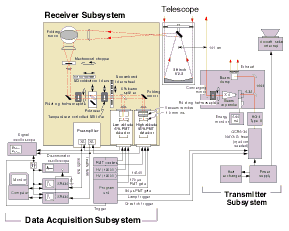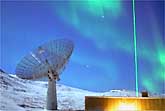 Instrumentation Instrumentation
The requirements of high spatial and temporal resolution and good signal statistics for middle atmosphere research prescribe Rayleigh lidar systems with high-energy, high repetition lasers, narrow laser beam divergences, narrow laser linewidths, high atmospheric transmittance with strong Rayleigh backscatter properties, large-aperture telescopes with submilliradian field of view, narrow spectral passband, and maximized optical throughput. These factors have been incorporated into the design of the ARCLITE Rayleigh lidar system.
System Layout

| Transmitter: Spectra-Physics GCR5-30 Nd:YAG |
| Wavelength |
532 nm |
| Pulse width |
7 ns |
| Pulse repetition rate |
30 Hz |
| Pulse energy |
560 mJ |
| Average power |
17 W |
| Seeded linewidth |
105 MHz |
| Beam divergence (X4) |
0.1 mrad |
| Receiver: Newtonian Telescope Configuration |
| Telescope diameter |
92 cm |
| Focal length |
203 cm |
| Field of view |
0.5 mrad |
| Number of channels |
2 |
1/2 l plate / Polarizer
Filter bandwidth:
Nighttime
Daytime |
l
10 Å
0.8 Å |
Signal Processing:
Photon Counting Data Acquisition System |
| Data system |
SR430 |
| Maximum count rate |
100 MHz |
| Range bin size |
192 m |
| Number of range bins |
1024 |
| On-line integration |
1 min |
| Computer system |
PC 486-33 |
| PMTs (2) |
EMI 9863B/100 |
|

  Data catalogues Data catalogues
  Data summary plots Data summary plots
  Publications Publications

  Instrumentation Instrumentation
  Research activities Research activities



 Asti Bhatt Asti Bhatt
 SRI International SRI International
 Phone (650) 859-3424 Phone (650) 859-3424
 asti.bhatt@sri.com asti.bhatt@sri.com
|


